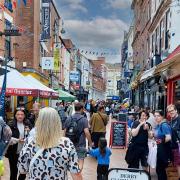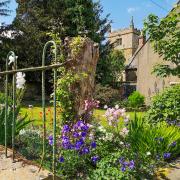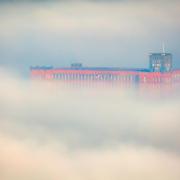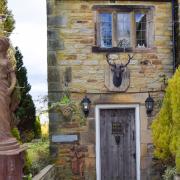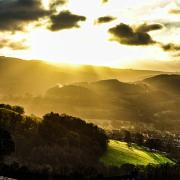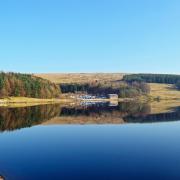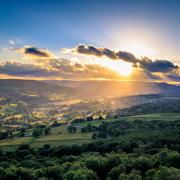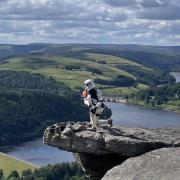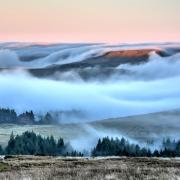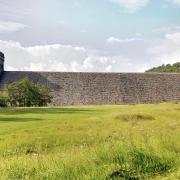Our only city, Derby was once regarded as the county town of the county before acquiring city status in 1977.
The city’s origins can be traced to a small area on the outskirts of the city known as Little Chester, which was once known as Derventio in Roman times.
The city comprises 17 wards: Abbey; Allestree; Alvaston; Arboretum; Blagreaves; Boulton; Chaddesden; Chellaston; Darley; Derwent; Littleover; Mackworth; Mickleover; Normanton; Oakwood; Sinfin; and Spondon.
Many of Derby’s suburbs were once more isolated as villages before the growth of the city brought them into its sphere, however each retains a sense of identity and community which strengthens the overall atmosphere of the city.
Derby is the 27th most populated city in the UK with around 261,000 inhabitants, with data from the 2021 census stating the city is home to 105,700 households.
Derby has given the world so much. It was here, many argue, that the Industrial Revolution began, with the construction of the Silk Mill in 1721 by John and Thomas Lombe, with UNESCO confirming the exceptional historical importance of the site by labelling it ‘the birthplace of the factory system’.
The city is currently bidding to be formally recognised as ‘the home of Great British Railways’ and it’s easy to see why given its rich heritage in this regard.
This is a city of innovation and industry, home to some of the world’s leading businesses in this field, including the iconic Rolls-Royce, Toyota, Alstom and many others.
Derby is the birthplace or former home of individuals who have influenced the world. Philosopher Herbert Spencer and artist Joseph Wright are just two and there are many more who were either born or spent considerable time here.
The city is sports-mad. Derbyshire County Cricket, based just outside the city, originated in 1870, formed at the Guildhall which still stands proudly in the centre today.
Derby County Football Club have twice been champions of England and Derby fans are renowned for supporting the club loyally in huge numbers.
Legendary manager Brian Clough, who famously managed both Derby and rivals Nottingham Forest, once claimed ‘Derby is a footballing town, Nottingham never has been.’
The city has a thriving cultural scene too, highlighted by the fact that it reached the final stages of the bid to become City of Culture for 2025.
‘Derby is a city that has always had creativity and innovation at its heart,’ reflected Adam Buss, who led Derby’s bid.
‘Derby is a diverse, global city and our City of Culture bid reflects both the unique qualities of the city and the unifying human qualities that bind us together.’

4 OF THE BEST
Derby Arboretum
Let’s be fair, there’s undoubtedly many arboretums around the UK which are delightful spots and lovely places to enjoy open spaces and nature.
Yet only one can lay claim to being the first specially-designed, public-owned urban park in the whole of Britain – and that’s Derby Arboretum.
Such was its novel nature, it is even believed by many that Derby Arboretum may have, at least in part, inspired the creation of New York’s Central Park, with the designer having visited Derby Arboretum in 1859 ahead of work starting on its creation shortly after.
Grade II-listed and both commissioned and gifted to the citizens of Derby by prominent businessman and philanthropist Joseph Stutt in 1840, Derby Arboretum lies around a mile out from the city centre and covers circa 19 acres in total.
Picturesque, wildlife-rich and with plenty to see and do for all ages, it’s the ideal spot for a break from the hustle and bustle of the city.
Derby Cathedral
One of the most visited and iconic buildings in Derby, Derby Cathedral – or to use its official name the Cathedral Church of All Saints - on Iron Gate is the Cathedral Church for Derby and Derbyshire.
Founded in 943, it stands proudly in the heart of the city, its beautiful and commanding summit dominating the skyline for miles around.
Still very much a place of worship, the cathedral is open to the public (set times and dates apply) and you certainly don’t need to be religious to enjoy and be taken aback by its beautiful interior and exterior.
Many of Derbyshire’s famous people are remembered here, including Bess of Hardwick who, in 1590, purchased an area in the church to build a crypt to house her remains and that of her descendants.
The cathedral also houses numerous memorials and plaques to renowned figures, such as the famed local artist Joseph Wright as well as Bonnie Prince Charlie.
More information, as well as opening times, can be found at derbycathedral.org.
Museum of Making
If you want to explore all of Derby’s incredible history and heritage in one place, the Museum of Making, which appropriately sits within the Derwent Valley Mills UNESCO World Heritage Site, is the place to go.
Based at the site of the Old Silk Mill, widely regarded as the site of the world’s first modern factory, here you can immerse yourself in 300 years-worth of local history in an engaging and contemporary space which has benefited from funding from the National Lottery Heritage Fund; Arts Council England; and the D2N2 Local Enterprise Partnership, alongside support from various local organisations.
What’s more, entry is free – although charges may apply for some of the temporary, specially-curated exhibitions.
The artifacts, displays, collections and more here will take your breath away, whilst various events take place throughout the year.
For more information, visit derbymuseums.org/museum-of-making.
Pickford’s House
Found on Friar Gate in the city, Pickford’s House is a Grade I listed Georgian town house which was designed and built in 1770 by renowned local architect Joseph Pickford, one of the leading architects in the reign of George III, and remained Pickford’s place of residence for the rest of his life.
Now a museum (since 1998), the property has been sympathetically furnished so that it offers a fascinating glimpse into life in Georgian times, with many of the rooms – such as the master bedroom, servants’ quarters, kitchen and scullery – appearing as they would have done during the period.
As you’d expect, there are many delights and unexpected surprises within and the museum is now in the care of the Derby Museums Trust, whose hands it has been in since 2012, having previously been owned by Derby City Council.
For more information, visit derbymuseums.org/pickfords-house.
READ MORE: Spending 24 hours in the city of Derby

5 PLACES TO VISIT
Cathedral Quarter
Voted ‘Best City Location’ at the 2016 Great British High Street Awards, this aesthetically pleasing part of Derby has been described as ‘the historic heart of the city’ and it’s easy to see why.
Boasting over 500 businesses – including many wonderful independent stores – the area is also a hive of cultural activity, is heritage-rich and offers superb dining options in abundance – not to mention its famous landmark, the stunning cathedral.
There’s something that ultimately feels very unique about the atmosphere here and whatever your reason is for visiting the city, a visit to the Cathedral Quarter is a must.
Darley Abbey
The word ‘historic’ is used a lot, however nobody would dispute the lovely and quirky village of Darley Abbey is just that.
A former mill village, Darley Abbey lies around 1.5 miles north of Derby city centre and is part of the Derwent Valley Mills UNESCO World Heritage Site.
Once the location of one of England’s largest and most prosperous Augustinian monasteries, Darley Abbey was also integral to the birth of the Industrial Revolution through the establishment of some of the earliest cotton spinning mills.
Nowadays, the noise of industry has given way to a far more peaceful atmosphere, optimised by Darley Park, which offers fine views of the city in the distance.
Spondon
Part of the City of Derby, Spondon was once a small village and has a fascinating history and proud heritage, boasting is own Spondon Historical Society.
In the 1330s, a huge fire – ‘the great fire of Spondon’ - began at the Malt Shovel, destroying the vast majority of the village. There remains a Malt Shovel today, which is Grade II-listed, although there is no concrete evidence it stands on the same site as the former.
There are numerous buildings of note to explore here, such as the 14th century St. Werburgh's Church, whilst the area is no stranger to coveted prizes – having won the Urban Community Award from Britain in Bloom in 2005.
Mickleover
Two miles west of Derby city centre, Mickleover is now one of Derby’s largest suburbs.
Once known as Magna Oufra (loosely translating to Great/large flat-topped ridge) it appears in the Doomsday Book of 1086.
These days, despite its growth, the village retains a great sense of community, with many events taking place through the year including the summer fete, Mickleover’s Got Talent and the popular Hot August Night family music concert, run in conjunction with the local football club.
With plenty of open spaces, such as Mickleover Meadows, great food, drink and accommodation options and numerous leisure facilities, it’s a lovely place to visit – and a stone’s throw from the delights of the city.
Littleover
Lying around three miles south west of the city and bordering Mickleover, Littleover’s name derives from Mickle Ufre in Old English, meaning ‘large hill’.
It has no fewer than 11 listed buildings within its boundaries, including St. Peter’s Church, which dates to Medieval times.
An attractive village, the White Swan, on Shepherd Street, is striking with its Tudor-esque exterior, whilst the Half Moon is believed to date to 1557 and remains a vibrant community hub.
King George V Playing Fields is a popular recreational area and the village offers numerous opportunities for those looking to indulge in a spot of retail therapy.

HIDDEN GEM
Derby’s organised trails
Exploring Derby, its sights and iconic landmarks can easily be enjoyed sporadically.
However, did you know that a series of formally-created trails have been devised to be enjoyed across the city, ensuring you don’t miss anything that Derby has to offer – especially when it comes to its scenic areas and magnificent heritage.
Short and easy to follow dedicated, routed trails include: Cathedral Quarter (eight trails); London Road North (one trail); Railway Quarter (two trails); St. Peter’s Quarter (four trails); and Western Derby (three trails).
By ticking off each of these collective 18 trails, you’ll experience the very best of Derby through a full and immersive exploration of its delights.
More information can be found at discover-derby.co.uk/trails where you’ll find an overview as well as a dedicated page for each one of the trails on offer.




